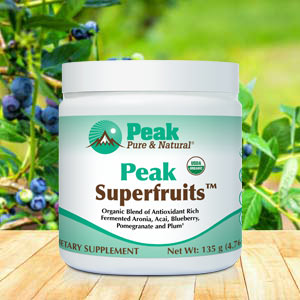Get Easy Health Digest™ in your inbox and don’t miss a thing when you subscribe today. Plus, get the free bonus report, Mother Nature’s Tips, Tricks and Remedies for Cholesterol, Blood Pressure & Blood Sugar as my way of saying welcome to the community!
The antioxidant diet: foods and supplements that fit the bill

There are lots of discussions about antioxidants, but not a lot of clarity. We often hear that antioxidants are a key to good health. While this is true, it’s only part of the story. Not all antioxidants are created equal. However, by better understanding oxidation (the damaging force that antioxidants combat), we can make the best possible choices to limit oxidative harm.
To oversimplify a bit, oxidation is a form of destruction. Rust is a type of oxidation. In some cases, destruction is a good thing. For example, some immune cells use oxidative destruction to kill dangerous pathogens.
However, the oxidation with which we’re concerned goes beyond normal limits. In the presence of illness, toxin overload, poor diet, too much or too little exercise, and other factors, the body accumulates too many free radicals, highly unstable atoms, or molecules that are missing an electron.
The missing electron puts free radicals in an oxidized state. That’s why these caustic molecules try to steal electrons from other atoms, generating more free radicals and more oxidization in an ongoing chain reaction.
Inflammation And Havoc
On a cellular level, this can get us into trouble. What happens if the molecule being oxidized is crucial, say a piece of DNA or the fats that form cell membranes? As it progresses, free radical oxidation can generate inflammation and wreak havoc on cells, tissues and organs, accelerating the aging process.
But this is where powerful molecules called antioxidants come to the rescue. They intervene by scavenging and deactivating free radicals, preventing further damage from this chain reaction. They help control inflammation since oxidation and inflammation are two aspects of the same situation.
Free radicals originate from a variety of sources including food, environmental toxins, UV sunlight and air pollution. The body has a number of powerful mechanisms to protect against them. The liver and other organs produce our own personal antioxidants. But sometimes the body just can’t keep up — that’s where we need to bolster the system.
Eat Your Antioxidants
Food can be a source of both free radicals and antioxidants, so it’s important to carefully choose what you eat. It’s no surprise that fried and processed foods generate the most free radicals. The freshness of foods and the way they’re prepared are as much a part of the story as your food choices. Heat, air and light exposure contribute to oxidation. Oils in particular are vulnerable to rancidity and damage.
Antioxidant Abundance
It’s easy to find an abundance of antioxidants in fruits and vegetables, particularly those that are deeply colored. Here are a few examples:
- Carotenoids: Block free radicals and are abundant in carrots, sweet potatoes, kale and tomatoes. These compounds include substances like beta-carotene and lycopene that work to neutralize free radicals.
- Flavonoids: Found in strawberries, blueberries, onions, cabbage and green tea.
- Cruciferous vegetables: Includes broccoli, kale and cauliflower. Rich in isothiocyanates, antioxidants known to fight cancer.
- Resveratrol: Found in red wine, grapes and blueberries. A powerful antioxidant touted for its anti-aging properties.
The Color Of Antioxidants
It’s worth noting that different antioxidants often concentrate in variously colored foods. This is important: Each variety has a unique way of protecting our bodies. That’s why preparing foods with varied colors is more than aesthetically pleasing: It is also good for health.
Here are some food prep tips to minimize oxidative damage:
- Buy small quantities so stored perishables are always fresh.
- Steam vegetables or lightly sauté using oils that can tolerate higher heat such as coconut, avocado or macadamia nut oils.
- Cook your veggies in broth, coconut water or a combination of oil and liquid to keep the heat at a lower temperature.
- Prepare raw foods just before serving rather than cutting and exposing them to the air.
Measuring Antioxidant Power: ORAC Scoring
One way of determining whether a food is rich in antioxidants is through its oxygen radical absorbance capacity (ORAC) score. This measures how powerfully that food neutralizes free radicals. Higher numbers are better. Here are a few examples:
- Apple juice (natural and unsweetened, preferably with the pulp): 414
- Unsweetened baking chocolate: 49,944
- Blueberries: 9,621
- Green tea: 1,253
- Fresh tarragon: 15,542
Chocolate Wonder
Chocolate can be very high in antioxidants. Chocolate contains polyphenols, compounds beneficial for the brain. A study at Temple University found that polyphenols from unprocessed cocoa protect brain cells from neurodegeneration.
However, that doesn’t mean we should be eating chocolate nonstop. Instead, choose a variety of antioxidant-rich foods for the best protection. Remember, antioxidants are an important aspect of good nutrition, but they’re not the only aspect. As a holistic practitioner, I strongly believe that antioxidants are just one component for a healthy lifestyle. Some nutritious foods may not have the highest ORAC scores, but they provide other important nutritional benefits. Be sure not to miss the big picture.
Antioxidant Supplements
Another way to bulk up on antioxidants is through supplements. There are a variety of vitamins, minerals and botanicals that increase antioxidant activity in the body and support health in other ways:
- Vitamins A, C, E and D3
- Selenium
- Lipoic Acid
- Beta glucans (found in mushrooms)
- CoQ10
- Curcumin
- Green tea
- Glutathione
- Honokiol
- Coffee
Glutathione is the master antioxidant made by the body and found in the liver, kidneys and lungs. Glutathione’s primary purpose is detoxification. (Those organs are most responsible for protecting us from toxins.) The compound also plays a role in regenerating vitamins A and C. Grape seed extract has been shown to boos the body’s production of the master hormone.
Honokiol has remarkable protective power. A number of studies have confirmed that purified Honokiol is a thousand times more powerful than vitamin E in its ability to scavenge free radicals, supporting heart health, liver health and more. Additional studies show that Honokiol offers powerful support for brain health.
Synergy
Like many nutrients and active compounds, certain combinations of antioxidants are greater than the sum of their parts. Using them together can boost their total effectiveness. For example, a study showed that a combination of herbs and green tea provides greater antioxidant activity than the individual herbs on their own. The study tested grape seed, pomegranate peel, cinnamon, Ginkgo biloba and amla. Researchers found that, combining these herbs increased their effectiveness at lower dosages.
Ultimately, variety is the key. Seek out a combination of antioxidant foods and supplements that fit your lifestyle. Fortunately, there are many options. And by carefully choosing a range of antioxidants, you can help your body win the ongoing battle with oxidation while enjoying colorfully delicious, healthfully prepared meals with family and friends.
Editor’s note: Have you heard of EDTA chelation therapy? It was developed originally to remove lead and other contaminants, including heavy metals, from the body. Its uses now run the gamut from varicose veins to circulation. Click here to discover Chelation: Natural Miracle for Protecting Your Heart and Enhancing Your Health!
For more health and wellness information, visit www.dreliaz.org.














